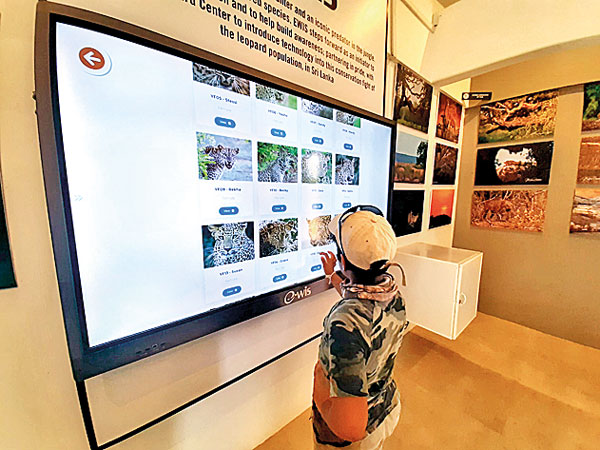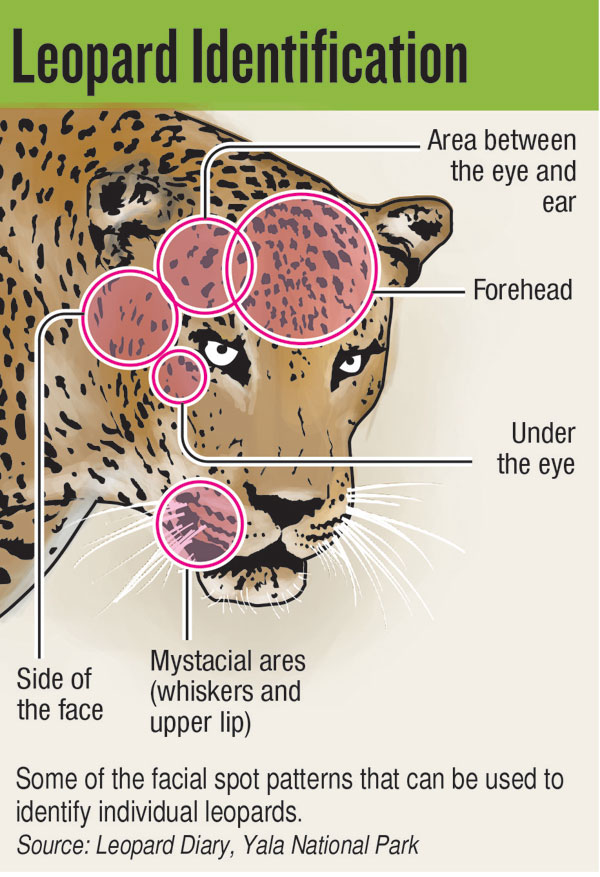News
Spotted! New app allows Yala visitors to ID leopards
An app has been developed to allow visitors taking photographs of leopards in the Yala National Park to identify each animal from its face markings.
Most of the leopards at the sanctuary’s Block-I region have been individually identified. Some have special markings such as scars that can be recognised easily but others, to the untrained eye, look alike.

A young wildlife enthusiast checks out leopard identification
Now, with a click of an app, Yala visitors can identify individual leopards caught in their lens.
Like human fingerprints, the spot patterns on a leopard’s face are unique to each animal, and this feature has been used in this app, which is simple to use.
A visitor needs to take a clear photograph of a leopard, showing its face from front and side, and upload the image onto the app, which compares the features of the photo with its database of identified leopards and produces the best-suited match.
The leopard ID app is, in fact, the icing on a cake of a larger initiative by a group of young wildlife conservationists and photographers in a project they called Yala Leopard Diary.
This team started gathering data in 2013 and established a Facebook page in 2017 as a platform to showcase identified leopards to the public and allow others to share their pictures of leopards for identification.
The Leopard Diary Team assigns a unique code for each leopard. This code starts from YM or YF, with Y referring to Yala and M or F for male and female.
The team also gives a nickname to the leopard, offering the person who first observed it the chance to suggest a name. For example, the 11th animal identified by the team was given the code YM11 and nicknamed Hitler because of its fierce nature.
The Yala Leopard Diary has now identified 137 leopards. They have been named after historical personalities such as Hitler, Caesar and Brutus or with Sinhala names such as Hamu (village headman), Hamine (wife of an important person) or, more notoriously, Harak Hora (cattle thief).
The app lists the leopards’ home ranges, with filtering for easy identification. The user can also sort identified leopards based on the last-seen date, enabling to go through the more frequent leopard sightings of Yala’s Block I and Block 5 regions.
The accuracy of leopard identification will improve as more photos are uploaded to the system, the app’s developers, Pramod Sendanayake and Chathura Dushmantha said.
 Currently, only the facial patterns are used to identify an animal, but the team is planning to expand identification methods using unique spot patterns such as those on a leopard’s flanks.
Currently, only the facial patterns are used to identify an animal, but the team is planning to expand identification methods using unique spot patterns such as those on a leopard’s flanks.
The Leopard Diary Team also lists the identified leopards in a family tree wherever possible. The sire of a leopard can be determined only through proper DNA analysis as many females mate with several males, or mating is not always documented, so the family tree has been developed using only the mothers’ genealogy on instances confirmed by observations from the stage when the leopards are still cubs.
Yala’s dominant males, Harak Hora and Hitler, are two cases of well-documented genealogy. Harak Hora was first spotted on the main road of Yala in Ratmal Wewa area when it was a two-month-old cub, with the mother YF1 Jeena and other siblings.
He has been seen frequently, with observers contributing to map its home range at nearly 18 sq km, and is now a mature male that instils fear in his prey, which enables it to expand his home range.
Hitler was first observed in 2014 along with his mother, Hamine, while it was still a cuddly cub. Like other young males, Hitler separated from his mother about two years later. It is now a shy yet lethal male that withstands all the tough challenges that the Yala wilderness brings him.
The Yala Leopard Diary team, led by Milinda Wattegedara, Dushyantha Silva, Raveendra Siriwardena and Mevan Piyasena, drew support from individuals and institutions to set up the Yala Leopard Information Centre last year.
The app, launched on October 23, can be freely accessed at www.yalaleoparddiary.com, and users are encouraged to upload clear shots for better results.
The app’s developers are wary that a thirst for spotting leopards could lead to unruly behaviour inside the park.
“We strongly urge Yala visitors not to use this application to start a race in counting Yala’s leopards,” Mr. Wattegedara urged.

